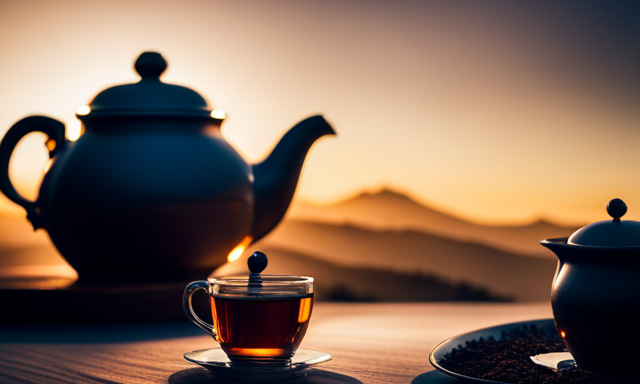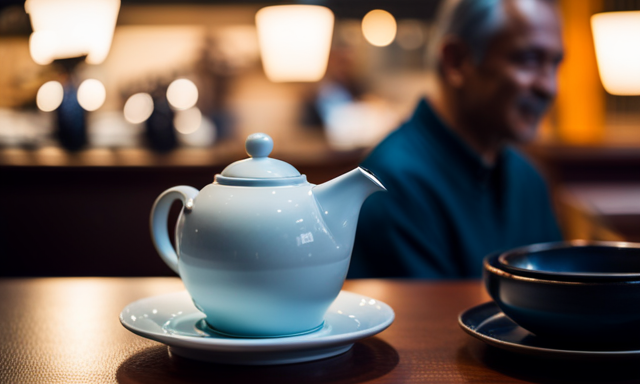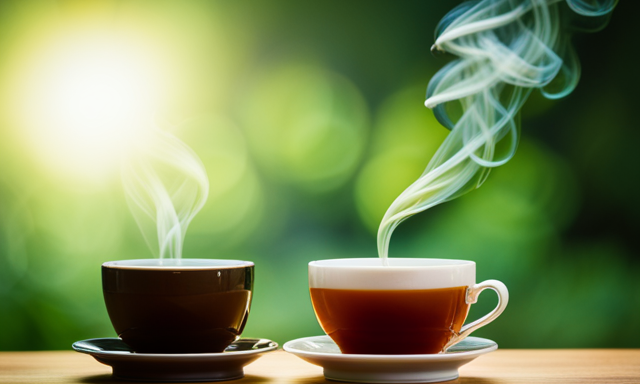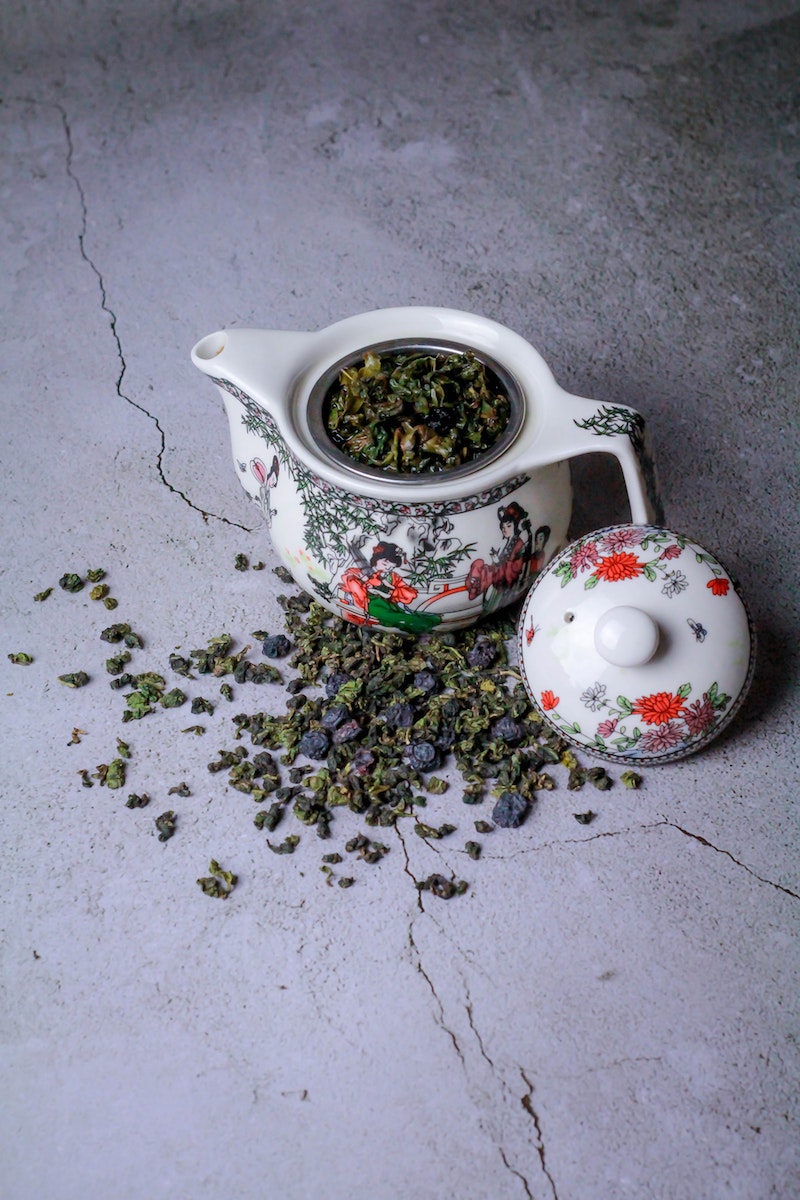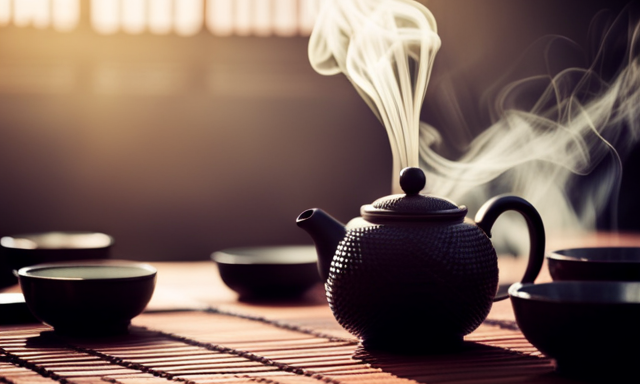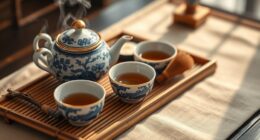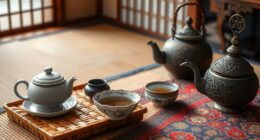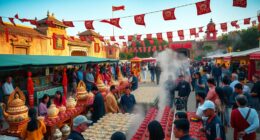Tea, oh the wonderful elixir of life! It’s a beverage that has been cherished for centuries, bringing comfort and solace to countless souls. Today, I invite you on a journey to explore the subtle nuances of two exceptional teas – Darjeeling and Oolong.
These teas, each with their own distinctive character, offer a delightful escape from the ordinary.
Darjeeling, a tea hailing from the misty mountains of India, is renowned for its delicate floral notes and exquisite aroma.
Oolong, on the other hand, originates from the lush tea gardens of China, boasting a rich and complex flavor profile that dances on the palate.
In this article, we will delve into the differences in flavor, appearance, and brewing techniques between these two captivating teas. We will also uncover the health benefits they provide and explore the cultural significance surrounding their consumption.
So grab a cup, sit back, and prepare to embark on a tantalizing adventure through the world of Darjeeling and Oolong tea.
Key Takeaways
- Darjeeling tea has a higher recommended water temperature for steeping (195-205°F) compared to Oolong tea (190-200°F).
- The steeping time for Darjeeling tea is generally 3-5 minutes, while Oolong tea can be steeped for 1-5 minutes.
- Darjeeling tea is rich in antioxidants and catechins, which can aid in weight management, while Oolong tea is known for improving digestion and promoting heart health.
- Oolong tea has potential anti-inflammatory and anti-cancer properties, and it also helps lower cholesterol and reduce cardiovascular risk.
Brief Overview of Tea Production
When it comes to tea production, you’ll be amazed by the meticulous process of cultivating and harvesting tea leaves. It involves a delicate balance of sunlight, rainfall, and skilled hands carefully plucking the leaves.
Tea production begins with the cultivation of tea bushes in suitable environments, such as high altitudes with cool temperatures and well-drained soils. The leaves are then carefully plucked, ensuring only the topmost leaves and buds are harvested.
After plucking, the leaves undergo traditional tea processing techniques. These techniques may include withering, rolling, oxidation, and drying. They are crucial in determining the flavor, aroma, and appearance of the final tea product.
The art of tea production requires expertise and attention to detail to produce high-quality teas.
Now, let’s delve into the introduction of darjeeling tea, a renowned tea variety known for its unique characteristics.
Introduction to Darjeeling Tea
Intriguingly, Darjeeling tea is a beloved variety renowned for its delicate flavor and unique characteristics. As an introduction, Darjeeling tea is grown in the Darjeeling district of West Bengal, India, which is nestled in the foothills of the Himalayas.
This region’s high altitude, cool climate, and misty air create the perfect conditions for tea cultivation. With a history dating back to the mid-19th century, Darjeeling tea has gained a reputation for its exquisite taste and aroma. The tea is harvested from the Camellia sinensis plant, specifically from the small-leaved Chinese variety.
The leaves are carefully plucked and processed to preserve their natural flavors. Now, let’s delve into the introduction of oolong tea, another fascinating variety with its own distinct qualities.
Introduction to Oolong Tea
Oolong tea is a fascinating type of tea that has its roots in traditional Chinese culture. It’s meticulously cultivated using precise methods that have been passed down through generations.
The oxidation levels of oolong tea can vary, resulting in a wide range of flavor profiles, from light and floral to rich and roasted.
Some popular varieties of oolong tea include Tie Guan Yin, Da Hong Pao, and Oriental Beauty.
Origins and Cultivation Methods
To fully understand the difference between Darjeeling and oolong tea, you’ll be interested to know that Darjeeling tea is exclusively grown in the Indian region of Darjeeling, while oolong tea is primarily cultivated in Taiwan and China. The cultivation methods for these teas also differ. Darjeeling tea is grown in high-altitude regions, typically above 6,000 feet, using traditional tea cultivation techniques. On the other hand, oolong tea is grown in a range of altitudes, from high mountainous regions to lower elevations, depending on the specific type. Taiwan is known for its mountain-grown oolong teas, while China produces a wide variety of oolong teas from different regions. Understanding the origins and cultivation methods of these teas provides insight into their unique characteristics and flavors. Moving on to oxidation levels and flavor profiles, we can explore how these factors further differentiate Darjeeling and oolong tea.
Oxidation Levels and Flavor Profiles
Now let me take you on a journey to explore the fascinating world of oxidation levels and the delightful flavor profiles that set Darjeeling and Oolong tea apart.
Oxidation levels play a crucial role in determining the flavors of these two teas. Darjeeling tea is a lightly oxidized tea, typically ranging from 10% to 70%. This results in a delicate and floral flavor profile, with notes of muscatel and a hint of astringency.
On the other hand, Oolong tea falls somewhere between green and black tea in terms of oxidation levels, usually ranging from 20% to 80%. Its flavor profile can vary greatly depending on the specific type, but it often offers a complex range of flavors, from fruity and floral to toasty and nutty.
With a deeper understanding of oxidation levels and flavor profiles, let’s now explore some popular varieties of Oolong tea.
Popular Varieties of Oolong Tea
As you delve into the world of Oolong tea, you’ll encounter an array of captivating varieties, each offering its own unique flavor profile and sensory experience. Some of the popular oolong tea blends include Tie Guan Yin, Da Hong Pao, and Oriental Beauty.
Tie Guan Yin is known for its floral and fruity notes, while Da Hong Pao offers a roasted and earthy flavor. Oriental Beauty, on the other hand, has a sweet and honey-like taste.
Oolong tea has gained popularity not only for its delicious flavors but also for its potential weight loss benefits. It is believed that the polyphenols and catechins in oolong tea can help boost metabolism and aid in weight loss.
Now, let’s explore the differences in flavor and aroma between Darjeeling and Oolong tea.
Differences in Flavor and Aroma
When you take a sip of Darjeeling tea, it’s like enjoying a fragrant and delicate bouquet of floral notes, while with Oolong tea, it’s like savoring a rich and complex blend of fruity and toasty flavors. The flavor profiles of these two teas are distinct and offer unique experiences.
Here are four reasons why Darjeeling and Oolong teas differ in flavor and aroma:
-
Darjeeling tea has a light and delicate taste, with hints of muscatel grape and a floral aroma that transports you to a serene garden.
-
Oolong tea, on the other hand, has a more robust flavor profile, combining fruity notes like peach and apricot with toasty undertones that add depth and complexity.
-
The brewing techniques for these teas also contribute to their distinct flavors. Darjeeling tea is best brewed with water at a lower temperature, around 185°F, to extract its delicate flavors. Oolong tea, on the other hand, benefits from a slightly higher temperature of around 200°F to bring out its full-bodied taste.
-
The length of brewing time also affects the flavor. Darjeeling tea is typically steeped for a shorter duration, around 2-3 minutes, to avoid bitterness. Oolong tea can be steeped for longer, around 3-5 minutes, to extract its rich flavors.
As we explore the variations in appearance and color, you’ll discover that Darjeeling and Oolong teas not only differ in taste, but also in their captivating visual characteristics.
Variations in Appearance and Color
Take a moment to observe the captivating visual characteristics of Darjeeling and Oolong teas, from their variations in appearance and color, that’ll surely entice your senses.
Darjeeling tea is known for its delicate and light golden hue, while Oolong tea exhibits a range of colors, from pale yellow to deep amber. These variations in color are a result of different processing methods and oxidation levels.
In terms of taste, Darjeeling tea has a floral and muscatel flavor, whereas Oolong tea offers a complex taste profile with notes of fruit, flowers, and sometimes even a hint of honey.
When it comes to brewing methods, Darjeeling tea is typically steeped at a lower temperature and for a shorter duration, while Oolong tea requires a slightly higher temperature and longer steeping time.
Transitioning into the next section, let’s explore the brewing techniques and recommendations for these two exquisite teas.
Brewing Techniques and Recommendations
Now that we’ve explored the variations in appearance and color between Darjeeling and Oolong tea, let’s delve into the art of brewing these exquisite teas. Brewing techniques play a crucial role in bringing out the unique flavors and aromas of each tea.
When it comes to Darjeeling, a delicate black tea, it’s recommended to use water heated to around 195 to 205 degrees Fahrenheit, which is just below boiling point. The steeping time for Darjeeling tea typically ranges from 3 to 5 minutes, depending on personal preference.
On the other hand, Oolong tea, with its partially oxidized leaves, requires a slightly higher brewing temperature of 190 to 200 degrees Fahrenheit. The steeping time for Oolong tea can vary from 1 to 5 minutes, depending on the desired strength.
Now that we’ve mastered the art of brewing, let’s explore the incredible health benefits of Darjeeling and Oolong tea.
Health Benefits of Darjeeling and Oolong Tea
Discover the remarkable health benefits that await you in a soothing cup of Darjeeling or Oolong tea. Both teas offer numerous health benefits, although they differ in their nutritional content.
Darjeeling tea is rich in antioxidants, which help fight against free radicals and reduce the risk of chronic diseases. It also contains catechins, which can boost metabolism and aid in weight management.
On the other hand, Oolong tea is known for its ability to improve digestion and promote heart health. It contains polyphenols that can help lower cholesterol levels and reduce the risk of cardiovascular diseases. Additionally, Oolong tea has been found to have potential anti-inflammatory and anti-cancer properties.
Transitioning into the next section about the ‘cultural significance and tea drinking traditions,’ it is fascinating to explore how these health benefits are intertwined with the deeply-rooted traditions of tea consumption.
Cultural Significance and Tea Drinking Traditions
Immerse yourself in the rich tapestry of cultural traditions and tea drinking rituals that have been passed down through generations, as you savor the intricate flavors and aromas that accompany this cherished beverage.
Tea ceremonies hold great cultural significance in many countries, serving as a way to honor guests, celebrate special occasions, or simply connect with loved ones. These ceremonies often follow a specific set of rituals and customs, with each step carrying its own symbolic meaning. For example:
-
Preparation: The tea is meticulously brewed, focusing on the precise temperature and steeping time.
-
Presentation: The tea is served in elegant teaware, such as delicate porcelain cups or traditional clay pots.
-
Appreciation: Each sip is savored, allowing the flavors to unfold and the moment to be cherished.
Tea drinking traditions also vary across cultures, with different countries embracing their own unique customs and rituals.
Transitioning to the subsequent section about where to buy and enjoy Darjeeling and Oolong tea, you can explore the diverse locations that offer these exquisite teas.
Where to Buy and Enjoy Darjeeling and Oolong Tea
Indulge in the exquisite flavors of Darjeeling and Oolong tea by exploring the various locations where you can purchase and savor these sought-after brews.
When it comes to Darjeeling tea, some of the best brands can be found in specialty tea shops and online platforms that source directly from the tea gardens in the Darjeeling region of India. Look for reputable brands like Makaibari, Castleton, and Jungpana for an authentic and high-quality experience.
For Oolong tea, you can find a wide variety of options in tea shops and online retailers. Popular brands include Tie Guan Yin, Da Hong Pao, and Dong Ding.
To truly immerse yourself in the world of Darjeeling and Oolong tea, consider going on tea tasting tours where you can learn about the different flavors, aromas, and brewing techniques while enjoying the serene tea gardens and picturesque landscapes.
Frequently Asked Questions
Are Darjeeling and oolong teas made from the same type of tea leaves?
Yes, darjeeling and oolong teas are made from the same type of tea leaves, the Camellia sinensis plant. However, the processing methods and flavor profiles of darjeeling and oolong teas differ significantly.
What are the different types of oolong tea available in the market?
There are various types of oolong tea available in the market, each with its unique flavor profile. Some popular types include Tie Guan Yin, Da Hong Pao, and Oriental Beauty. Brewing techniques for oolong tea vary based on the specific type.
Can Darjeeling tea be considered a type of oolong tea?
No, darjeeling tea cannot be considered a type of oolong tea. While both have distinct flavor profiles and require specific brewing techniques, darjeeling tea is a black tea while oolong tea falls under the category of partially oxidized tea.
Are there any specific health benefits that are unique to Darjeeling tea?
Darjeeling tea offers unique health benefits such as improved digestion, reduced stress, and enhanced cardiovascular health. Compared to other types of tea, it contains higher levels of antioxidants and has a milder caffeine content.
What is the cultural significance of Darjeeling and oolong tea in different regions?
Tea holds a deep cultural significance in various regions, evoking a sense of tradition and unity. Traditional tea ceremonies are celebrated with reverence, fostering a connection to one’s heritage and shared values.
Conclusion
In conclusion, the difference between Darjeeling and Oolong tea is like discovering two distinct worlds within the vast realm of tea. Darjeeling tea captivates with its delicate floral notes and subtle muscatel flavor, while Oolong tea entices with its rich, complex taste and unique fruity undertones. The variations in appearance, brewing techniques, and cultural significance further add to the allure of these teas. So, if you’re a tea enthusiast yearning for new experiences, delve into the realm of Darjeeling and Oolong tea, and let their secrets unfold sip by sip.

